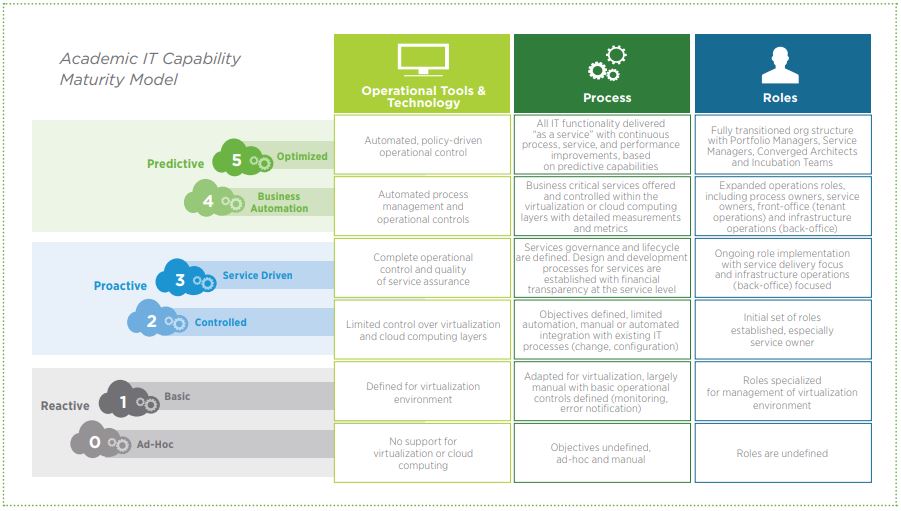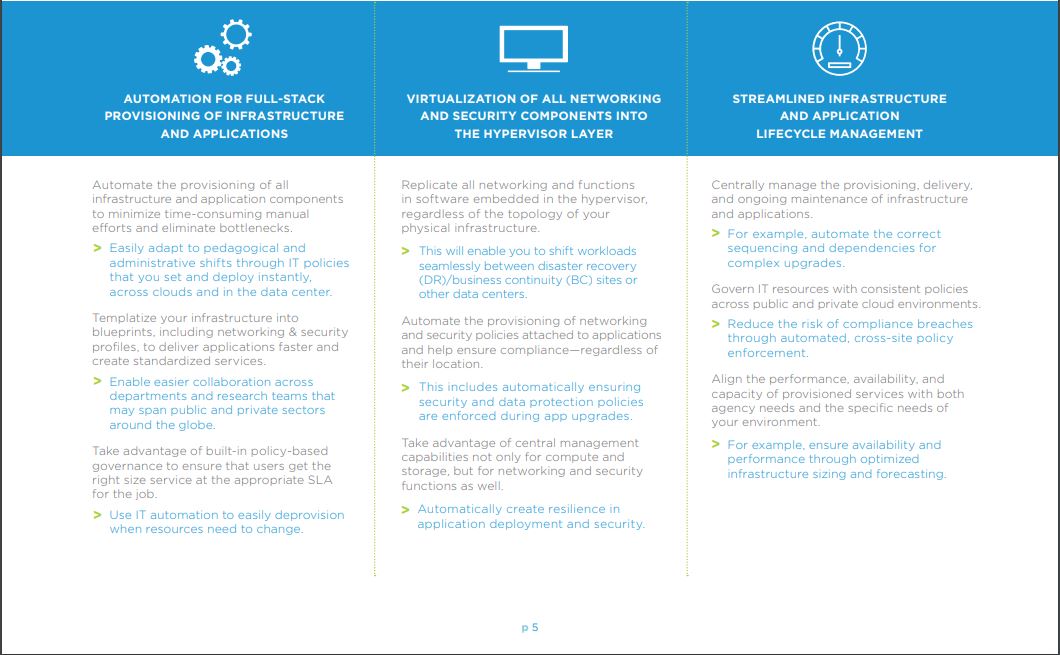
How Modern IT Services Powering the Digital Campus Help Academic Institutions Attract Students and Retain Talent
Driving Limitless Learning and Increasing Resources for Innovation
Digital transformation is fundamentally shifting how academic institutions deliver higher education. From mobile learners and technology in the classroom to leveraging cloud, campus IT teams today are challenged to deliver new services while protecting student privacy and institutional data. Higher education IT teams are modernizing their IT foundations, tapping the power of software and cloud to deliver legacy and modern applications faster, more securely, and at scale. Virtualization powers the delivery of infrastructure and applications, with automation dramatically improving operational efficiency. Automation helps ensure applications of all types, from legacy and web to SaaS and cloud-native, are instantly available, reducing overhead and improving user experiences while making IT more manageable.
Addressing Key Challenges
Higher education administrators, professors, and an increasingly diverse array of students, including non-traditional students, are quickly embracing technology as never before, pushing the boundaries in research, learning, and in how they build and define community. Campus IT teams have always struggled with the tendency of academic institutions to have distributed and departmentalized IT silos, so the need to unify and govern technology use is more critical than ever.
Institutional IT teams looking to modernize and automate IT have been looking to address four critical higher education concerns:
1. How do we drive greater agility to support limitless learning?
2. How do we deliver institutional outcomes faster?
3. How do we better protect student and institutional data?
4. How do we reduce costs?
Accelerating Agility
The good news is there’s a path to IT modernization your campus may already be on or can start today. The key is IT automation. A mission-critical component of any software-defined data center (SDDC), cloud infrastructure, and management strategy, automation helps you deploy and scale new services and provision infrastructure instantly. This gets your IT team out of the labor-intensive operations business and drives incredibly efficient, dynamic resource management. For your institution this means more agile IT that can support new initiatives with minimum disruption, differentiating your organization’s ability to successfully adapt as new opportunities arise.
Building the Case for Automation
It’s no secret automation accelerates time to benefit.
Higher education organizations interested in maturing IT capabilities at their own pace—from reactive to proactive to predictive—can combine a proven model with trusted partner expertise to uncover paths that accelerate institutional outcomes.

The Power of Automating Higher Education IT
Delivering more than IT improvements, IT automation:
Accelerates agility:
• Transform IT operations by eliminating manual, time-consuming, error-prone, low-value IT maintenance tasks
• Gain the time and resources required to support campus innovation efforts
• Meet demands for new app delivery models, enabled by a multi-cloud environment while still supporting legacy apps
Speeds institutional outcomes
• Move toward self-service provisioning of infrastructure, while giving students, faculty, and staff what they need faster
• Improve resource utilization through automated allocation and reclamation of unused capacity
• Manage application lifecycles with no manual overhead
• Position your infrastructure to be ready to add, move, or remove workloads in an instant
• Support research alliances, special projects, and initiatives such as cybersecurity learning environments, or the piloting of new programs
Improves risk management
• Simplify auditing and reporting as workloads and application diversity grow
• Meet regulatory or compliance standards for research
• Streamline and standardize compliance by automating workflows and enabling blueprint creation for infrastructure
• Proactively reduce internal and external threats, even with personally-owned devices in the mix
Lowers costs
• Virtualize compute, storage, networking, and security on a single foundation to lower costs (CapEx and OpEx)
• Easily manage apps on-premises and in public clouds, such as Amazon Web Services, from one platform
• Adopt public cloud infrastructure, as needed, for capacity
The Foundation: A Software-Defined Data Center
If you’ve already virtualized compute in your data center, you can now easily extend virtualization to your entire stack. Then, from there to the cloud, to safely deliver data and apps to and from anywhere. You can move one workload at a time or scale more quickly. Either way, it can all be managed—data center, private or public clouds, SaaS apps—from a common management foundation that leverages your team’s existing knowledge and skill sets.
A software-defined data center (SDDC) advances innovation and helps improve education by eliminating rigid technology silos between infrastructure and apps, and between app types. Adding automation to the SDDC environment speeds institutional and technical goals:
• Compute – If compute virtualization is already helping your campus reduce costs, increase
workload availability and performance, and minimize or eliminate downtime, you are ready
for the next step.
• Storage – Storage virtualization pools together server-attached flash devices and/or hard disks to provide a highly resilient shared datastore suitable for a variety of workloads to improve storage utilization, easily scale without disruption, and drastically lower TCO.
• Networking & Security – Network virtualization reproduces the physical network in software, enabling IT to reduce provisioning time from days to minutes, improve operational efficiency by reducing manual tasks, and provide a more secure data center with security policies attached to individual workloads.
A software-defined approach enables university IT teams to more easily deliver the always-on platform that is increasingly expected by students, professors, and administrators. And of course, even the most demanding applications run flawlessly on software-defined infrastructure.

Overcome the Limitations of Manual IT Processes
Deploy automation to help your campus IT team speed traditionally time-consuming, error-prone IT processes.
Deliver Infrastructure and Applications Faster
Automation reduces time spent provisioning infrastructure and apps, so faculty, students, and staff have the data, apps, and information they need, when they need it. It also helps ensure university administration has access to all the resources it needs to move quickly on new opportunities or challenges in the education environment, such as shifts in recruiting or the marketing of new programs.
Eliminate IT Bottlenecks
University IT teams are deploying IT automation to eliminate the bottlenecks of manual infrastructure configuration, provisioning, and scripting, and application deployment. In a full SDDC, IT teams can model infrastructure and applications as “blueprints” with embedded automation and policies, defined by roles and identities. App blueprinting streamlines resource management for capital and operational savings. It also gives IT teams the agility to finally offer their users choice by transforming the entire service lifecycle.
Reduce Administrative Overload
For the first time, college and university IT teams can manage legacy applications with virtually no overhead. On-premises applications are part of the higher education landscape today and will likely remain so for some time; not only that, but campus IT teams must deal with additional legacy applications resulting from bringing departmental IT into the fold. Automation eases administration through instant infrastructure provisioning and manages legacy apps with the consistency of IT policies that you control.
An Evolution to Adoption
Academic institutions rely on VMware’s proven solutions to deliver limitless learning, including the ability to deliver diverse applications to any environment, from the “classroom without walls” to the public/private collaborations occurring in research and other endeavors. A software-defined approach provides a safe, proven path to modern IT that spans data center, cloud, digital workspace, and security. As with any challenge, a huge opportunity exists to do more than meet rising demands, but to improve the experience of faculty, students, researchers, staff, and IT teams while harnessing the power of cloud to lower cost and improve agility.
Beyond VMware vSphere: Leverage Your Teams’ Existing Skill Sets
Now your campus IT team can easily extend virtualization beyond compute to include storage, networking, and security all managed through a common foundation for simplified administration. Move workloads into the SDDC at your own pace. Use a common platform to manage virtual machines, networks, and storage. VMware Cloud Foundation™ provides integrated cloud infrastructure and cloud management services so you can run enterprise applications in both private and public environments.
Public Cloud? Meet VMware Cloud on AWS
VMware Cloud™ on AWS is an on-demand service that enables you to run applications across VMware vSphere® based cloud environments with access to a broad range of AWS services. Powered by VMware Cloud Foundation, this service integrates vSphere, VMware vSAN™ (virtual storage) and VMware NSX® (virtual networking) along with VMware vCenter® management, and is optimized to run on dedicated, elastic, bare-metal AWS infrastructure. With this service, academic IT teams can manage cloud-based resources with familiar VMware tools.
Because cloud is a strategy, not a destination, VMware helps institutions gain a better understanding of the needs of their workloads and ensure those workloads always have what they need to achieve academic and operational goals. VMware’s open and interoperable approach to hybrid cloud saves university IT teams the time and hassle associated with reinventing, replatforming, and rewriting application code, and together, VMware and VMware Cloud Providers help ensure higher education institutions have a platform that provides freedom and control today and into the future.
Gain Greater Agility and Meet Education Compliance Demands
Automation is required to gain the speed and agility today’s campuses need. VMware vRealize® Automation™, part of VMware vRealize® Suite™, is a comprehensive, proven, enterprise-ready platform that speeds service delivery and improves IT operations for both learners as well as the developers who support efforts such as research. vRealize Automation helps IT teams gain control while giving academics and administration the flexibility to use any application from any cloud. vRealize Automation extends all of your policies to all workloads—whether they are in a public, private, or hybrid cloud. Auditing and reporting are streamlined. Gain peace of mind with automation, knowing that deployment of services to any endpoint is consistent, repeatable, and governed by policy.
Drive Limitless Learning at Scale
Academic organizations are leveraging IT automation to ensure consistent, repeatable delivery of applications and infrastructure, so faculty, staff, students and those they collaborate with all have a consistent experience—even for universities extending across international or public/private boundaries.
Using vRealize Automation and NSX together, IT staff can model complete, multi-tier application environments that bake in network and security policies. Efficiency is greatly improved through repeatable processes, seamlessly delivered time and time again. Through native integration of vRealize Automation and NSX
• Dynamically build networking and security services into your blueprints, standardizing delivery and reducing manual overhead
• Leverage micro-segmentation to protect east-west traffic and secure applications easily and consistently, regardless of where they live and throughout their lifecycle
Learn More about VMware Cloud Solutions for Higher Education
The speed, efficiency, and consistency of automation enable campus IT teams to improve delivery and user experience while managing costs. When your campus IT team automates, it eliminates bottlenecks. Most important, teams ensure a foundation of faster service delivery in a modern technology ecosystem that includes legacy, cloud-native, and SaaS apps, and both public and private clouds, reliably and at scale.
Only by modernizing and automating IT can your institution rise to the challenge of meeting everevolving student and faculty expectations. Modernization and automation are also the surest ways to drive greater agility, deliver institutional outcomes faster, better manage risk, and reduce costs.
Contact one our Academic Technology Experts to learn more or to request a quote!

